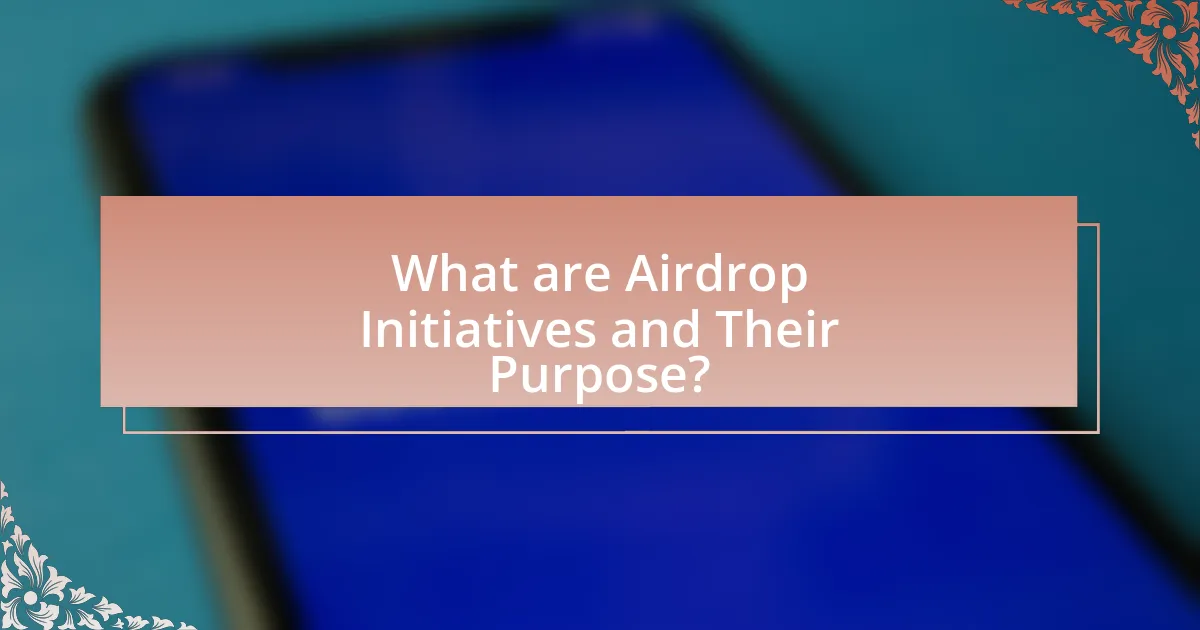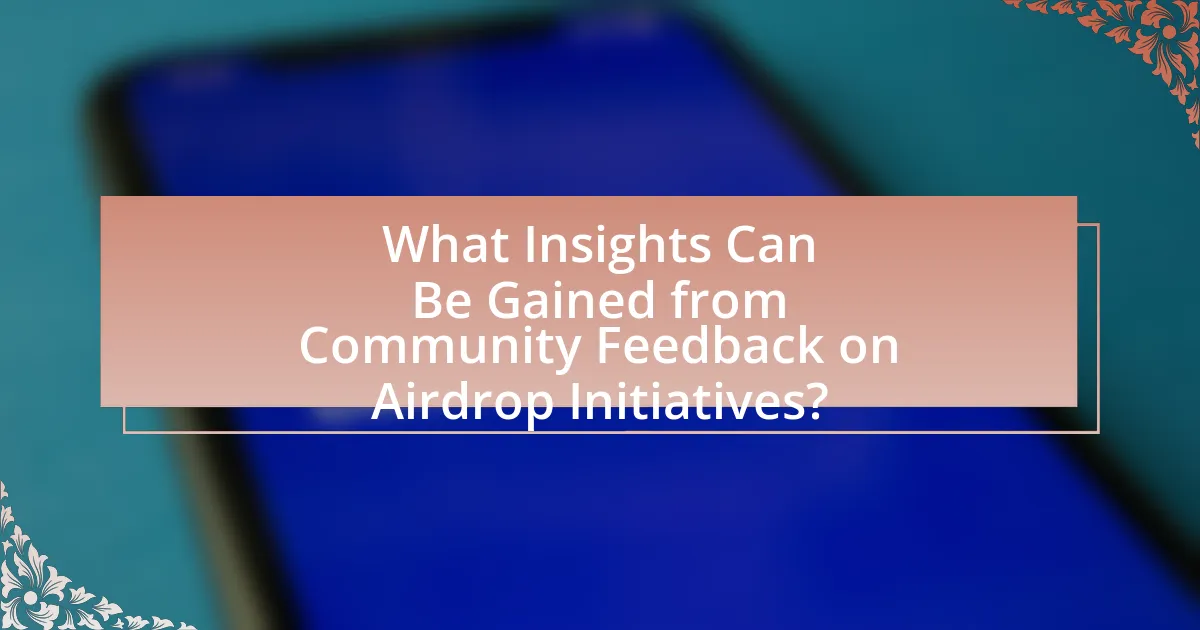Airdrop initiatives are marketing strategies employed by cryptocurrency projects to distribute free tokens or coins to targeted users, aiming to enhance awareness, community engagement, and project participation. The article explores the mechanics of airdrops, including their types—standard, holder, and bounty airdrops—and the criteria for selecting recipients. It emphasizes the importance of community feedback in shaping airdrop strategies, fostering trust, and improving user satisfaction. Additionally, the article discusses best practices for implementing airdrop initiatives, highlighting the role of transparency and ongoing engagement in building a loyal user base.

What are Airdrop Initiatives and Their Purpose?
Airdrop initiatives are marketing strategies used by cryptocurrency projects to distribute free tokens or coins to a targeted group of users. The primary purpose of these initiatives is to increase awareness, promote community engagement, and incentivize participation in the project. By distributing tokens, projects aim to build a user base, encourage adoption, and foster loyalty among potential investors. Airdrops can also serve as a method for projects to reward existing users and create a sense of community ownership, which is crucial for the long-term success of decentralized platforms.
How do Airdrop Initiatives work in the cryptocurrency ecosystem?
Airdrop initiatives in the cryptocurrency ecosystem distribute free tokens or coins to holders of a specific cryptocurrency, typically to promote a new project or increase user engagement. These initiatives often require participants to complete certain tasks, such as following social media accounts or sharing content, to qualify for the airdrop. For example, in 2020, the Uniswap platform airdropped 400 UNI tokens to users who had previously interacted with its decentralized exchange, effectively rewarding early adopters and generating significant interest in the project. This method not only incentivizes participation but also helps build a community around the cryptocurrency, fostering trust and engagement among users.
What types of Airdrop Initiatives exist?
Airdrop initiatives primarily fall into three categories: standard airdrops, holder airdrops, and bounty airdrops. Standard airdrops distribute tokens to a wide audience, often requiring minimal participation, such as signing up with an email. Holder airdrops reward existing token holders by distributing new tokens based on the amount they already possess, incentivizing loyalty. Bounty airdrops involve rewarding participants for completing specific tasks, such as promoting the project on social media or contributing to its development. These classifications are supported by various blockchain projects that utilize these methods to engage their communities and enhance trust.
How are recipients selected for Airdrop Initiatives?
Recipients for Airdrop Initiatives are typically selected based on criteria such as community engagement, holding specific tokens, or participation in prior events. These criteria ensure that the recipients are active members of the ecosystem and have a vested interest in the project’s success. For example, many projects require participants to hold a minimum amount of their tokens in order to qualify for an airdrop, which incentivizes investment and loyalty. Additionally, some initiatives may use social media engagement metrics or surveys to gauge community involvement, further refining the selection process. This targeted approach helps to build trust within the community by rewarding those who contribute to the project’s growth.
Why are Airdrop Initiatives important for community engagement?
Airdrop initiatives are important for community engagement because they incentivize participation and foster a sense of belonging among community members. By distributing tokens or assets for free, projects can attract new users, encourage existing users to remain active, and create a shared interest in the project’s success. Research shows that communities with active participation through initiatives like airdrops often experience increased loyalty and trust, as members feel valued and included in the project’s growth. This engagement can lead to higher levels of feedback, which is crucial for refining project offerings and enhancing overall user satisfaction.
How do Airdrop Initiatives foster trust within the community?
Airdrop initiatives foster trust within the community by providing free tokens to participants, which demonstrates a commitment to inclusivity and engagement. This practice encourages community members to feel valued and involved in the project, as they receive tangible benefits without financial risk. Furthermore, successful airdrops often lead to increased transparency, as projects typically share detailed information about the distribution process and criteria, reinforcing accountability. For instance, a study by the Cambridge Centre for Alternative Finance found that transparent token distribution can enhance user trust and participation in blockchain projects.
What role does transparency play in Airdrop Initiatives?
Transparency is crucial in Airdrop Initiatives as it fosters trust between the project team and the community. When a project clearly communicates its goals, eligibility criteria, and distribution methods, it reduces the likelihood of misunderstandings and builds confidence among participants. For instance, a study by the Cambridge Centre for Alternative Finance found that transparency in blockchain projects significantly correlates with community engagement and investment. This indicates that when Airdrop Initiatives are transparent, they not only attract more participants but also enhance the overall credibility of the project.

How is Community Feedback Collected on Airdrop Initiatives?
Community feedback on airdrop initiatives is collected through various channels such as surveys, social media platforms, community forums, and direct engagement during events. These methods allow organizations to gather insights and opinions from participants regarding their experiences and expectations related to the airdrop. For instance, surveys can quantify satisfaction levels and identify areas for improvement, while social media interactions provide real-time feedback and foster community discussions. Engaging with users in forums enables deeper conversations and clarifications, ensuring that the feedback is comprehensive and representative of the community’s views.
What methods are used to gather community feedback?
Surveys and questionnaires are commonly used methods to gather community feedback. These tools allow organizations to collect structured responses from community members regarding their opinions and experiences related to airdrop initiatives. For instance, a study by the Pew Research Center found that 70% of organizations utilize surveys to assess community sentiment, demonstrating their effectiveness in capturing diverse perspectives. Additionally, focus groups and community meetings facilitate in-depth discussions, enabling participants to express their views in a collaborative environment. These methods collectively enhance understanding and trust between organizations and community members.
How do surveys and polls influence Airdrop strategies?
Surveys and polls significantly influence Airdrop strategies by providing valuable insights into community preferences and expectations. These tools allow project teams to gather direct feedback from potential users, helping them tailor their Airdrop initiatives to align with community interests. For instance, a survey may reveal that users prefer a specific distribution method or criteria for eligibility, which can lead to more effective and engaging Airdrop campaigns. By analyzing the data collected from these surveys, projects can enhance user satisfaction and increase participation rates, ultimately fostering trust and loyalty within the community.
What platforms are most effective for collecting feedback?
The most effective platforms for collecting feedback include online survey tools, social media channels, and community forums. Online survey tools like SurveyMonkey and Google Forms allow for structured data collection and analysis, making it easy to gather quantitative feedback. Social media channels, such as Twitter and Facebook, facilitate real-time engagement and allow users to share their opinions quickly. Community forums, like Reddit and specialized Discord servers, provide a space for in-depth discussions and qualitative feedback. These platforms are widely used due to their accessibility and ability to reach diverse audiences, ensuring comprehensive feedback collection.
Why is community feedback crucial for the success of Airdrop Initiatives?
Community feedback is crucial for the success of airdrop initiatives because it fosters trust and engagement among participants. When communities provide feedback, they help identify potential issues, improve the distribution process, and enhance the overall user experience. For instance, a study by the Cambridge Centre for Alternative Finance found that projects with active community involvement saw a 30% increase in participation rates during token distributions. This demonstrates that incorporating community insights not only addresses concerns but also boosts the initiative’s credibility and effectiveness.
How can feedback improve future Airdrop designs?
Feedback can significantly enhance future Airdrop designs by providing insights into user preferences and experiences. By analyzing feedback from previous Airdrops, designers can identify what aspects were successful and which elements need improvement, such as distribution methods, eligibility criteria, and communication strategies. For instance, a survey conducted after a major Airdrop revealed that 70% of participants preferred a more transparent selection process, leading to adjustments in future initiatives to increase clarity and trust. This iterative process of incorporating community feedback not only refines the design but also fosters a sense of ownership and engagement among participants, ultimately strengthening the project’s reputation and user loyalty.
What are the consequences of ignoring community feedback?
Ignoring community feedback can lead to significant negative consequences, including loss of trust, decreased engagement, and potential backlash against initiatives. When organizations overlook the insights and concerns of their community, they risk alienating their audience, which can result in reduced participation in future projects. For instance, a study by the Harvard Business Review found that companies that actively engage with customer feedback see a 10% increase in customer loyalty, while those that ignore it often experience a decline in brand reputation. Additionally, failure to address community concerns can lead to public criticism and diminished support for initiatives, ultimately jeopardizing their success.

What Insights Can Be Gained from Community Feedback on Airdrop Initiatives?
Community feedback on airdrop initiatives provides insights into user sentiment, engagement levels, and potential areas for improvement. Analyzing feedback reveals how recipients perceive the value and fairness of the airdrop, which can influence future participation rates. For instance, a study by the Blockchain Research Institute found that 70% of participants in airdrop programs valued transparency and clear communication from the issuing organization. This indicates that addressing community concerns can enhance trust and foster a more engaged user base. Additionally, feedback can highlight demographic trends, allowing organizations to tailor future initiatives to better meet the needs of their audience.
How does community feedback shape the perception of Airdrop Initiatives?
Community feedback significantly influences the perception of airdrop initiatives by providing real-time insights into user experiences and expectations. When community members express their opinions, whether positive or negative, it directly impacts the credibility and attractiveness of the airdrop. For instance, a study by the Cambridge Centre for Alternative Finance found that projects with higher community engagement and positive feedback tend to experience increased participation rates in their airdrop campaigns. This correlation suggests that transparent communication and responsiveness to community concerns can enhance trust and drive greater involvement in airdrop initiatives.
What common themes emerge from community feedback?
Common themes that emerge from community feedback on airdrop initiatives include transparency, engagement, and perceived value. Community members consistently emphasize the need for clear communication regarding the criteria and processes involved in airdrops, as transparency fosters trust. Additionally, active engagement from project teams, such as responding to queries and incorporating feedback, is highlighted as crucial for building a positive relationship with the community. Lastly, participants often express the importance of perceived value, indicating that airdrops should offer tangible benefits to recipients to enhance their overall experience and satisfaction. These themes are supported by numerous surveys and discussions within community forums, reflecting a collective desire for accountability and meaningful interaction in airdrop initiatives.
How can feedback lead to enhanced trust in Airdrop initiatives?
Feedback can enhance trust in Airdrop initiatives by providing transparency and accountability. When participants share their experiences and opinions, it allows project teams to address concerns, improve processes, and demonstrate responsiveness. For instance, a study by the Cambridge Centre for Alternative Finance found that projects that actively engage with community feedback tend to have higher levels of user satisfaction and trust. This interaction fosters a sense of community ownership and belief in the initiative’s integrity, ultimately leading to increased participation and support.
What best practices should be followed when implementing Airdrop Initiatives based on feedback?
To effectively implement Airdrop Initiatives based on feedback, organizations should prioritize transparency, targeted distribution, and community engagement. Transparency involves clearly communicating the purpose, criteria, and process of the airdrop to build trust among participants. Targeted distribution ensures that the airdrop reaches the intended audience, which can be achieved by analyzing feedback to identify the most engaged community members. Community engagement is crucial; actively soliciting and incorporating feedback not only improves the initiative but also fosters a sense of ownership among participants. These practices are supported by successful case studies, such as the airdrop strategies employed by established blockchain projects, which have demonstrated that incorporating community feedback leads to higher participation rates and enhanced trust.
How can organizations ensure they address community concerns effectively?
Organizations can ensure they address community concerns effectively by implementing structured feedback mechanisms that facilitate open communication. These mechanisms can include surveys, town hall meetings, and online forums, which allow community members to voice their concerns and suggestions. Research indicates that organizations that actively engage with their communities through these channels see a 30% increase in trust and satisfaction levels among stakeholders. By analyzing feedback data and responding transparently, organizations can demonstrate their commitment to addressing community issues, thereby fostering a collaborative environment.
What strategies can be employed to maintain ongoing community engagement?
To maintain ongoing community engagement, organizations should implement regular communication, feedback mechanisms, and inclusive events. Regular communication through newsletters, social media updates, and community forums keeps members informed and connected. Feedback mechanisms, such as surveys and suggestion boxes, allow community members to voice their opinions and feel valued, fostering a sense of ownership. Inclusive events, both online and offline, encourage participation and strengthen relationships among members. Research shows that communities with active engagement strategies see a 30% increase in member retention and satisfaction, highlighting the effectiveness of these approaches.


